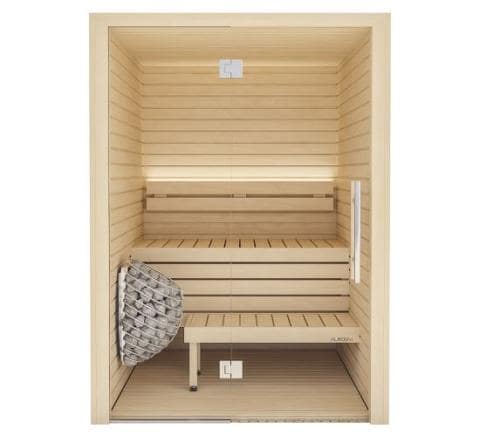9 Simple Techniques For Traditional Sauna
Table of ContentsSome Known Details About Traditional Sauna What Does Traditional Sauna Do?The Definitive Guide for Traditional SaunaThe 4-Minute Rule for Traditional Sauna
A lot of the weight lost in a sauna is water loss and is re-gained upon rehydrating. Without an uncertainty sauna can be an important part of a healthy weight loss program. To look at the distinctions in between conventional and IR saunas, I will divide these right into verifiable, theoretical, and fabricated differences.Hence, the best point in the saunawhich goes to the ceiling straight above the sauna heateris commonly in between 185 and 190 F. Traditional Sauna. Claims that a conventional sauna surpasses 200 F is simply not real and not appropriate for electric saunas sold in the United States. The temperature for a far-infrared sauna is generally established in between 120 and 140 F; nevertheless, unlike the typical sauna, the goal in and IR area is not to accomplish a heat
Due to this, the temperature level distinction is practically irrelevant, given that extreme sweating causes both sauna types, yet the technique of heating up the body is various. In an IR sauna the bather will really feel hot and will certainly sweat a lot, but at a lot lower temperature levels. Thus, if the objective is to spend longer time periods in the sauna, the IR sauna is an excellent choice.

Traditional Sauna for Beginners
When the heat is accomplished, the aspects cycle on and off to keep the high temperature level. The majority of standard sauna individuals delight in putting water over the rocks to create steam to elevate sauna humidity levels. The benefits of putting water over the rocks include: making the room a lot more comfy, dampening the nasal passages, and allowing the usage of aromatherapy by mixing vital oils with the water.
In a far-infrared sauna, the warm front permeate the body to successfully heat up the body and elevate the body core temperature level. To attain this increased temperature, Far-infrared emitters develop infrared power which is close to the exact same wavelength as that which the body naturally emitsoften referred to as the "Essential Variety" of 7 to 14 microns), so the power is well gotten by the body.
When the power enters the body, it creates the body temperature to increase and ultimately causes sweating. In an infrared sauna it is very important for the emitters/heaters to remain on practically regularly. Since there is no mass of rocks to preserve warmth, the sauna will cool if the emitters shut off.
As pointed out over, the sauna bather in an infrared area wishes to place himself in front of operating emitters to obtain maximum benefit from the warm. The heating time for the 2 rooms can be extremely various, depending on just how the areas are used. For a traditional sauna, a bather needs to allow 30-40 mins for the space to achieve a preferred temperature level and to correctly pre-heat the rocks.
Getting My Traditional Sauna To Work
A well constructed sauna will typically attain a temperature of 150-160 F in concerning 30-40 mins. For hotter temperatures, the room might require to heat for a longer duration.
To some, 15 minutes was "squandered" while the infrared energy heated the timber panels as opposed to warming a body, while others locate a pre-heated Home Page area to be a lot more comfortable and think an elevated beginning temperature level is essential to start sweating. The length of recommended use for each and every space is approximately the very same (10-15 minutes per session); nonetheless, due to the reduced air temperature levels and the ability image source to feel the effects of infrared warmth quicker than a conventional sauna, it is not unusual for an individual to invest a total amount of 20-30 minutes in an infrared sauna.
Standard saunas often tend to be bigger (thus make use of even more electrical energy) than infrared saunas, although traditional saunas are definitely readily available in one and two individual sizes as well. For a two-person standard sauna, 5x6 or 5x7 size is most popular. The top bench can conveniently seat 2 or three individuals and is also long sufficient to lie down throughout the sauna session.


The ordinary expense per kWH of power in the united state is approximately $0.11, so a 4.5 kW heating unit will cost around $.50 to run for one hour, if the heating system runs continuously for one hour. Normally a sauna heating unit will run for 75% of the first hour and 50% of subsequent hours on given that the elements cycle once the established temperature level is achieved.
Traditional Sauna Fundamentals Explained
A 2 person far-infrared area is typically physically smaller sized than a conventional sauna, frequently regarding 4' x 4' or smaller. The IR home heating system is usually 1.5-1.7 kW making use of a 120 volt 15 amp plug-in service. Given that the space can be made use of quicker than a sauna area, we will certainly assume the area is used for to of an hour including warm up time.
There is a rarely talked about difference in the social experience in between the two areas. While our culture has shed some like this of the social advantage of the conventional sauna experience, it can be really socially rewarding. From family members time in the sauna, to heart-felt discussions with better halves, to sauna partiesthe conventional sauna experience can bring about intimate mingling.
Most higher end infrared areas consist of tinted light therapy, sound systems and full-glass fronts.